Irving, TX Pollen and Allergy Report for Summer 2023
Pollen Allergy Trends in Irving, TX
When is pollen lowest in Irving, TX?

February
Lowest month total PPM
Avg. PPM
When is pollen highest in Irving, TX?

March
Highest month total PPM
Avg. PPM
How does pollen in Irving, TX compare to Texas?
Irving has a higher average PPM than the state of Texas.
Irving yearly avg PPM:
Texas yearly avg PPM:
How does pollen in Irving, TX compare to the USA?
Irving has a higher average PPM than the USA.
Irving yearly avg PPM:
USA yearly avg PPM:
Is pollen worse this year in Irving, TX?
Spring 2023 was worse than spring 2022.
Spring 2023 PPM:
Spring 2022 PPM:
Average PPM in Irving, TX


Irving, TX Pollen and Allergy Breakdown by Month
Grass
When is grass pollen highest in Irving, TX?
February has the highest grass pollen in Irving, TX with an average PPM of
When is grass pollen lowest in Irving, TX?
December has the lowest grass pollen in Irving, TX with an average PPM of
Tree
When is tree pollen highest in Irving, TX?
March has the highest tree pollen in Irving, TX with an average PPM of
When is tree pollen lowest in Irving, TX?
July has the lowest tree pollen in Irving, TX with an average PPM of
Weed
When is weed pollen highest in Irving, TX?
December has the highest weed pollen in Irving, TX with an average PPM of
When is weed pollen lowest in Irving, TX?
February has the lowest weed pollen in Irving, TX with an average PPM of
Irving, TX Pollen Monthly Breakdown by Pollen Type
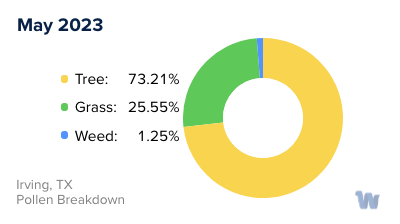



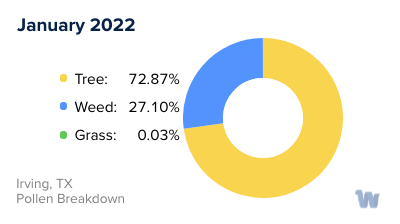

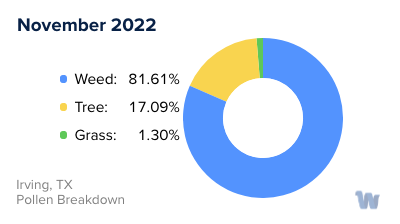






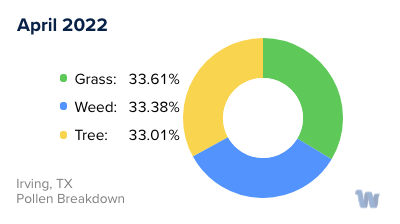
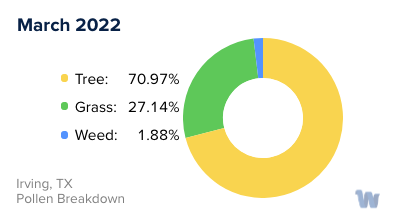
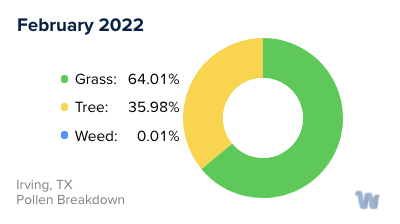
Pollen and Hay Fever in Irving, TX
If you're living in Irving, Texas, or planning to spend time there, it's important to be aware of the pollen landscape. The primary producers of pollen in Texas, which can contribute to allergies, are grasses, trees, and weeds. Among these, the most common sources of allergens include Bermuda grass, Timothy grass, Sweet vernal grass, Ragweed, as well as trees like Cedar, Oak, Elm, Ash, Pecan, and Cottonwood.
Pollen allergies in Texas can flare up at different times throughout the year, depending on the specific allergen. You can experience allergy symptoms during any time of year, but they are more common in the spring, summer, and fall.
Pollen counts in Texas are typically at their peak in December, January, May, and September. During these months, if you are sensitive to pollen, you may notice your allergy symptoms intensifying. Conversely, during the evenings, the pollen counts tend to be lower, which might give some reprieve to those with pollen allergies.
It's essential to note that everyone's allergy response is individual. Some people might have a stronger reaction to certain types of pollen, while others might not be affected at all. Understanding the types of pollen prevalent in your area and the seasons during which they peak can help you better anticipate and manage your allergy symptoms, even though this discussion does not include specific treatments or remedies.
In summary, residents of Irving, Texas, need to be aware of the wide variety of pollen producers, including various types of grasses, trees, and weeds, and the varying seasons during which these allergens peak.


